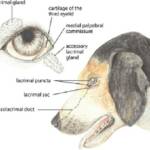Many dog owners have seen their companion scoot their rump across the floor in a disconcerting way. Sometimes you may smell a fishy odor or see brown droplets after the scoot. If you have, your dog’s anal glands were probably full and itchy, making your pet rub and also try to empty their glands.
People also have anal glands but ours don’t fill up and we don’t use it to mark territory. Ours are more small remnants that are not significant. In dogs it’s a different story.
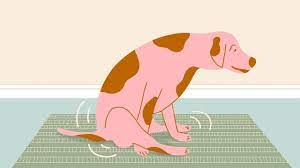
What are anal glands and where are they?
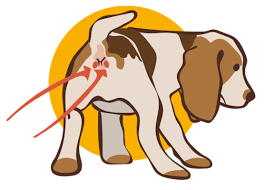
Anal glands are basically small sacs located just inside the rectum on each side. On the left between the 6-7 o’clock position and on the right between 4-5 o’clock. There are pores to the gland. Normally, every time your dog defecates the glands are pressed and emptied.
However, some dogs have small pore openings or conditions that inflame the gland and make them hard to empty; that’s when they scoot. This liquid may play a role in territorial marking and communication between our canine friends.
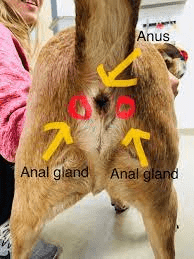
While anal glands can be emptied by your veterinarian, there are other problems that can occur in the glands. One such problem are tumors. Anal sac tumors are abnormal, usually cancerous growths in the gland. They are not too common but serious and left untreated are generally fatal.
These tumors can affect any dog but older dogs and certain breeds such as spaniels, German Shepherds, and dachshunds are at higher risk. Females seem to be affected more frequently than males.
These tumors can metastasize and create issues as they spread locally and to distant sites of the body.
Ultimately, they can bring illness, discomfort and a decreased quality of life to your dog. For this reason, it is essential to catch these tumors early and to treat them as soon as possible.
What causes anal sac tumors?
As with most cancers, a cause has not been identified. However, genetics and environmental factors probably play important roles.
Although we don’t have a definite cause, we do have some understanding of what’s happening at a microscopic level. As in most tumors, cells start abnormally dividing and multiplying in an unregulated way. This rapid cellular replication creates a cancerous.
The mass makes the anal sac larger and can get large enough that defecation becomes difficult. More trouble follows when cancer cells spread to other parts of the body and make new tumors.
The cells often spread to lymph nodes, which are small lumps of immune tissue scattered throughout the body. They can also spread to essential organs, such as the lungs, liver and kidneys.
The other problem caused by anal gland cancer is this type of tumor is often implicated in dysregulation of calcium metabolism in the body and may cause increased the amount of calcium in the blood.
High calcium levels can damage the kidneys as well as cause muscle tremors, heart beat abnormalities and increased thirst and urination.
Early signs of anal sac tumors
early on, many dogs won’t show any signs. They may scoot however just like when their glands are full. If your veterinarian checks, he or she may feel the mass and recommend obtaining a sample for pathology.
If the tumors are not caught early, you may notice that your dog is having trouble defecating. If the tumor increases blood calcium levels, your dog may drink and urinate more, tremble, vomit and seem weak. If the mass spreads to the lungs, owners may hear coughing.
Other symptoms include:
- Swelling at the rear end
- Licking the rear end more than usual
- Bleeding around the anus
- Bloody stool
How are anal sac tumors diagnosed and treated?
Your veterinarian will conduct a rectal exam to feel for the tumor. If a mass is suspected, your veterinarian will likely recommend sedated needle aspirations for clinical pathology.
If it is determined to be cancerous, your veterinarian will recommend labwork, chest X-rays and an abdominal ultrasound to make sure obvious spread isn’t seen. If it isn’t, surgical removal (and in some cases radiation treatment) will be recommended.
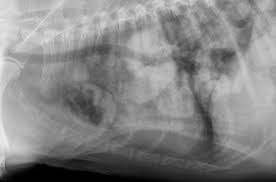
Until your dog is scheduled for treatment, your veterinarian may recommend stool softeners to make it easier for your dog to defecate and give medications to lower blood calcium.
They may also refer you to a veterinary surgeon and oncologist for removal, radiation and chemotherapy if warranted.
Surgery has been shown to lengthen the survival time of dogs with anal sac tumors. However, tumors may eventually reappear if cancer cells are left behind and the cancer cells may have already spread to other sites at the time of removal.
Both chemotherapy and radiation therapy can have serious side effects that your veterinarian as well as veterinary specialists will talk to you about.
What is the prognosis?
Survival times for dogs with anal sac tumors are variable but on average range from about 1-2 years. However, every dog’s situation is different because prognosis depends on many factors such as:
- The size of the tumor
- Spread throughout the body
- Blood calcium levels
- Type of treatment
Dogs who receive surgery or any type of treatment generally have a better prognosis whereas the outlook is often much poorer for dogs with large tumors, higher calcium levels, and extensive spread of the tumor.
How can I prevent anal sac tumors?
There’s no way to prevent anal sac tumors from developing. Early detection is important and may be achieved through routine rectal exams performed by your veterinarian. In fact, many times anal sac tumors are found when your veterinarian does a rectal examination.

